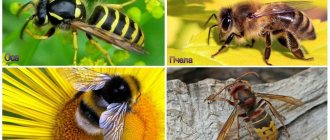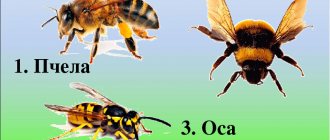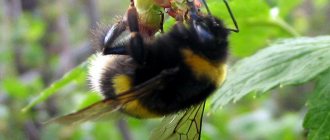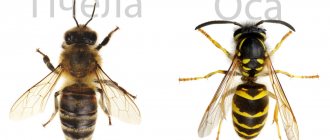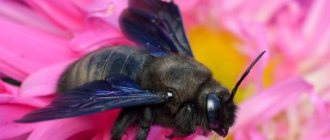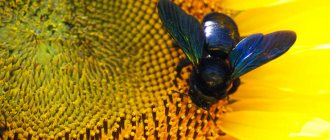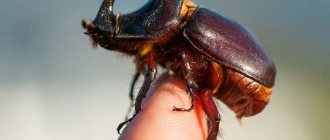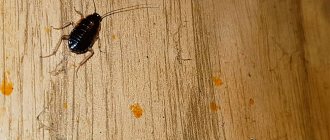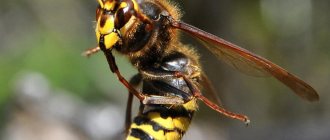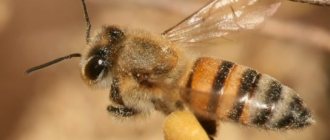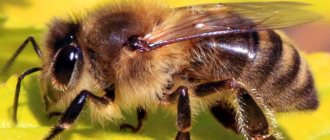Wasp, bee, bumblebee and hornet - everything you need to know about stinging insects. External descriptions and differences. Where they live and how they build nests. What do they eat and who is the hunter? How dangerous are they for humans? Why is the disappearance of these stinging representatives dangerous? Features of insects and benefits for people.
The most common insects include wasps, bees, bumblebees and hornets, which we can encounter not only when traveling in nature, but also in the city. To understand these insects we need to get to know them better, then we can easily learn to distinguish them.
Some consider them very dangerous, because when they bite they release poison, which is very difficult for the human body to perceive. Let's consider what similarities and differences a wasp, a bee, a bumblebee and a hornet have, what benefits they bring and why they are dangerous.
How to distinguish insects
If you are far from entomology, but care about the preservation of beneficial bees, then it is enough to know the most striking visual differences. In flight, these signs are impossible to catch, but in a calm state they are striking:
- Coloring. The differences are significant. The insects are striped, but the intensity of color and their contrast are more pronounced in the wasp. It will have more elegant colors. Bright, sunny yellow stripes mixed with black. Bees are more modest. Their yellow is calm, muted, the transition is less contrasting. Individual representatives of the families have white or brown colors in their arsenal.
- Villi. Bees are focused on pollination. Therefore, they are covered with clearly visible fluff - special villi for the transfer of pollen. You wouldn’t suspect a wasp of such hard work: its abdomen is bare, even glossy.
- Wasps are elongated. They can even be called elegant. Bees are more rounded and dense.
If you look really biasedly, you will definitely see lumps of pollen on the bees’ legs.
They also differ in their habitat. If you find a nest, the wax honeycombs point directly to the bees. Wasps build them from clay, plant debris, and wood.
Coloring
The coloring options for insects are so numerous that it is not difficult to distinguish between a bumblebee, a wasp and a bee. The bee is distinguished by dark brown shades. In cartoons, there is a certain stereotype, which is why honey collectors are drawn with stripes. If you look closely at the images of insects, their difference immediately catches your eye.
Bumblebees and wasps can have completely monotonous colors, including stripes. There are glossy wasps, which are distinguished by rainbow colors, and typhias, for example, are painted in a monotonous black color. However, most people believe that wasps have exclusively classic colors, with a predominance of yellow and black stripes. It should be noted that representatives of other families that do not have similar coloring can be dangerous and can bite just as painfully.
Who bites harder?
The greatest aggression is inherent in hornets and wasps, which have a thin sting - they can use it a couple of times, while deeply piercing the skin. The bites are painful and burning, and the site of the attack becomes severely swollen. There is also a risk of causing an allergic reaction. Do not forget that the wasp gives a signal, so you may encounter a whole swarm of insects that continue to exist after being bitten.
It is more difficult to anger bees, but the sting remains in the wound. They can attack only once, as a result the bee will die. The blow is delivered only when there is great danger. The bites are not very painful.
Bumblebees are considered the most benevolent and can attack only in exceptional cases. The bites are also not very painful. Only the female has a sting; when bitten, it does not remain in the affected area of the skin. Severe allergies and increased body temperature may occur. Bites are very dangerous for children.
Read further:
Bee, wasp, bumblebee and hornet - description, differences in appearance, behavior, lifestyle
Wasp, bee, bumblebee and hornet: what are the similarities and differences between these insects
Hornet and wasp - who stings more, consequences of a bite, allergic reaction, first aid after an attack
How is a wasp different from a bee: description, appearance, lifestyle, behavior, bites, danger
Preventing insect stings
It is difficult to avoid encounters with insects outside the city, since there a person finds himself visiting nature. Therefore, it is worth carrying allergy pills with you. When visiting the apiary, wear special clothing. When making jam, close the windows so as not to tempt wasps and bees. When picking fruit in the garden, protect your hands with thick gloves or inspect each fruit for insects.
The favorite delicacy of wasps, hornets, and bees is ripe sweet fruits: pears, plums, apples
When relaxing in the forest or on the river bank, be careful:
- when looking for a parking place, first check to see if there are insect nests nearby;
- do not walk barefoot;
- do not disturb the houses of wasps and hornets, they will certainly attack;
- when they see a stinging insect, they behave calmly and do not wave their arms so as not to provoke aggression;
- the biting insect is not killed; the body of the killed one exudes an enzyme that will provoke an attack by its relatives.
When going outdoors, do not use perfumes containing apple and banana fragrances. The listed odors attract hornets and wasps.
Stinging insect bites are treated with compresses and ointments. In case of allergies, antihistamines are used. If after a bite the victim’s breathing is impaired and his consciousness is swimming, immediately call an ambulance
To avoid insect attacks, be careful when picking fruit, making jam and finding a place to camp in nature.
Nature of the bites
The wasp stings are much more painful, but the nature of the bites has its own similarities.
As mentioned above, wasps can sting several times. At the same time, there is a risk of infection, since wasps often visit places where there is complete unsanitary conditions. As for the bee, the sting is not so dangerous, since the only thing bees do is collect nectar from flowers - honey plants.
Every person should be able to provide first aid for wasp and bee stings. Ignorance of these rules, as well as illiterate actions, can harm human health. This is especially true for people prone to allergies, young children, expectant mothers and people with poor health.
As a result of a bee or wasp sting, the following characteristic signs appear:
- Swelling of the bite site.
- Redness.
- Severe throbbing pain.
- Deterioration in health.
In cases where the human body is hypersensitive, the reaction may be as follows:
- The swelling increases, the tissues of the larynx, tongue and facial area swell.
- Breathing problems appear: attacks of suffocation are possible.
- The heart begins to beat much faster.
- Redness spreads over a significantly larger area of the body.
- There may be an increase in body temperature or cold sweat.
- The person develops a feeling of anxiety.
Anaphylactic reactions occur if the degree of intoxication of the body is more severe:
- The man loses consciousness.
- Hemorrhages in the eye area.
- The person's skin becomes pale.
- The pulse is barely palpable or is 100 beats per minute, or even more.
- The pressure is either high or low.
- Trouble breathing, the victim can barely breathe.
- Tachycardia develops.
- Painful sensations appear in the abdomen and breasts.
- The wound is very itchy.
- Nausea and dizziness may occur.
Stung by a wasp: first actions
This is not the first generation of parents who have used proven first aid actions for a wasp sting. The main thing is to do everything quickly.
What to do first? It is important to leave the scene of the attack, but you should not try to kill the wasp, especially if it is not alone. Such actions will most likely cause another attack
The sting may contain a large number of bacteria, so it is recommended to treat the bite site with an antiseptic
To do this, you can use hydrogen peroxide, alcohol, or, as a last resort, soap and water. To stop the spread of toxins, the bitten arm or leg is bandaged over the wound with a tourniquet or scarf. Drinking plenty of liquids: tea, compotes, water helps speed up the process of removing poison. You can relieve the pain by bandaging the bite site and putting something cold or just ice on top. Half an onion, tomato or apple also relieves symptoms well: you need to put it on the site of the bite.
After providing first aid, you should continue to monitor the condition of the victim, since swelling can begin either immediately after the bite or a day later. If the wound is very swollen (1.5-2 times) and the person complains of feeling unwell, consult a doctor.
Wasp and man
Given their aggression, a person from early childhood acquires intolerance to these Hymenoptera, since everyone is bitten almost every year. Summer residents and gardeners who relax and work in the fresh air often encounter this insect.
Application in medicine
Wasps in some cases can not only cause harm, but also benefit humans. In folk medicine, abandoned wasp nests, which are completely sterile inside, have been used. An alcoholic infusion of them perfectly treats joint and bone diseases; a decoction of the powder has a beneficial effect on stool and the functioning of the gastrointestinal tract. Also, powder or infusion is used for taking baths, which improve muscle tone and give lightness to the body.
Danger to humans
Urban wasps, being a constant companion of a person, can bring him a mortal threat. Representatives of this species are capable of attacking not only singly, but when the nest is threatened, even in groups of several dozen.
Their bites are extremely painful and cause severe allergies. Why they are so aggressive in ordinary everyday situations is difficult to understand.
In summer and autumn you need to be extremely careful, as these insects are everywhere. It is especially worth keeping an eye on children - their reaction to a bite can be extremely severe. You can accidentally put an insect with a grape, a piece of watermelon, or a glass of drink into your mouth.
- allergy;
- hypertension or hypotension;
- temperature increase;
- dizziness, nausea, vomiting, diarrhea;
- loss of orientation in space;
- convulsions;
- swelling of the larynx;
- death.
Treatment for wasp sting allergy
An allergic reaction to a bee or wasp sting has quite acute and quickly manifested symptoms. In this case, you need to act quickly in order to slow down the spread of toxins as much as possible and neutralize their effect on the body.
The victim is given an antihistamine that suppresses the development of the allergic process. It can be:
The drugs are taken in the dosage and frequency prescribed by the doctor. Medicines such as Erius, Eden, Claritin, Kestin are indicated for children.
In addition to antiallergic medications, special ointments and gels will help to relieve swelling from a wasp sting:
These products also have an antihistamine effect, relieve redness and swelling, and relieve itching.
It is possible to use hormonal drugs, for example, Fluorocort or Diprosalic, but you need to take into account possible side effects.
It is also advisable to prescribe adsorbent drugs:
These drugs bind toxins and quickly remove them from the blood, thereby cleansing the body of poison.
In case of severe manifestations of allergies, the victim will be helped by:
The victim is urgently hospitalized and provided with all necessary care in a hospital setting.
Formation of nests
Real bees and their families build nests in a hive or in another place if a ready-made hive is not available. Their nests consist of honeycombs that have a regular shape, in contrast to the nest itself, which can have any shape. The shape of the nest depends on the shape of the cavity in which the bees build their nest.
As for wasps, they build nests on their own in any suitable place. As a rule, wasp families are not as numerous as bee families, so their nests are not large. Mostly, wasp nests are found in the form of an elongated top or in the form of a curved plate of irregular shape. If you look at this plate, it resembles a sunflower, but without seeds.
Wasps build nests from cellulose glued together with their saliva. If you pick up the nest, it resembles an object glued together from thick cardboard.
Behavior of insects in times of danger
Bees protect their hive and can only sting if there is a threat to the home. Insects transmit a signal with lightning speed about the appearance of a stranger, after which the entire swarm flocks to defense. After the attack, the bee dies, leaving a sting at the site of the bite.
Wasps and hornets are characterized by rather aggressive behavior. It is unknown when they can attack; insects sting at every opportunity and it doesn’t matter whether the nest is threatened or not. After a bite, they do not die; their sting is long and similar to the shape of a spear.
The bumblebee is a non-aggressive and peaceful insect. There is less resemblance to a wasp than to a bee. Can sting in case of defense (only female bumblebees have a sting). Unlike a bee, it does not leave its sting at the site of the bite.
Properties of the sting
Indian scientists, together with colleagues from Ohio State, conducted research and determined that wasp and bee stings were not created so simply. There are differences between them:
- curved in a wasp;
- direct from the bee.
Both insects have two movable barbs at the end, sharp as a dagger. They make it easier to pierce the body surface.
Using equipment, scientists discovered a feature in both stings - the presence of voids, due to which the sting is light but durable.
wasp sting
Bee sting
An important discovery was that the stings at the base are less elastic and soft than those at the top. Because of this, the sting enters the skin painlessly; the insect has time to inject poison before the person feels it and tries to shake it off.
Studies have also shown that insects bite at an angle, which is why the sting remains strong for a long time.
On the other hand, the bee cannot remove the sting because it has serrations and part of the intestine breaks off, causing the insect to die.
The wasp sting is thin, curved and pointed. After injecting the poison, the insect easily pulls it out.
The composition of the toxic substance varies among different types of wasps. But only females sting, since their sting (in addition to their weapon) is an ovipositor.
If suddenly these stinging insects disappear
For several years now, environmentalists have been talking about the real and serious problem of a significant reduction in the number of bumblebees and bee colonies.
Perhaps for many, the disappearance of these people will go unnoticed, just as no one will notice, for example, a wasp circling around a person eating a watermelon. But in fact, everything is not as simple as it might seem at first glance, because they are very important for nature and bring great benefits.
First of all, it should be noted that these insects are in a constant fight against pests that the average person simply does not notice, but at the same time, we can say that they protect the crop that a person collects.
And one more very important and most important point - they are pollinators of trees, shrubs and other plants, and there are no other millets in nature, so their disappearance will certainly affect people’s lives, and, unfortunately, not in the best way.
Who bites harder?
Hornets and wasps are the most aggressive; they have a thin sting with which they pierce the skin deeply several times. The bite is painful and burning, the affected area swells greatly. This may cause an allergic reaction. Wasps are also able to give a signal for the entire swarm to join them. These insects continue to live after being bitten.
It is difficult to anger a bee, but it leaves a sting in the body, striking only once, and subsequently dies. Bees sting only in extreme danger. Their bite is not so painful.
The most benevolent of all is the bumblebee; he attacks in exceptional cases. Its bite is less painful. Only the female has a sting; she does not lose it, and sometimes bites several times. A bumblebee sting can cause severe allergies and fever, and is especially dangerous for children.
Hornets
The most dangerous relatives of my favorite bees for humans. Not only are they intimidating in size (they can be up to 6 cm in length), but they also do not have serrations on their stingers. This means that after being bitten they do not die, but continue to sting until the poison runs out. And they have a lot of it. So much so that meeting them can be fatal.
But despite the horrors that I told you about, you cannot destroy their hives when you meet them. Hornet larvae feed on insects. A large family of hornets can eat half a kilo a day. So without them, the ecosystem will be very disrupted.
Their houses are very ugly on the outside and extremely slender on the inside. Outwardly, they resemble the thermal insulation on old panel houses - sloppy, pimply heaps. Inside such houses there are even compartments with honeycombs of several floors.
I think I wrote about everyone. If I missed anyone, tell me. I missed your comments.
External differences
Despite the fact that wasps and bees belong to the same order Hymenoptera and are essentially related, they have many differences
We will not take into account exotic types of flyers and consider:
- common types of paper wasps;
- honey bees;
- hornets - typical representatives of social wasps;
- bumblebees are ambassadors from the family of real bees.
Color
You can identify the difference between a bee and a wasp visually by their appearance. The color of the bee is muted yellow with black stripes. The body is covered with hairs.
The wasp is distinguished by a smooth body without signs of hair, rich yellow and contrasting black stripes. The bright “robe” of the insect is noticeable from a great distance. But the wasp does not need thick hair, because collecting nectar is not its main business.
The color of the body is one of the main signs of difference between a bee and a wasp.
Body structure
It is not for nothing that the wasp is famous for its wasp waist - the interception between the abdomen and chest. In the photo, the graceful curve is visible especially clearly. The body shape is elongated and elongated. Upon closer examination, powerful jaws and thin legs stand out.
The hornet is very similar in appearance to the wasp, but only with more developed jaws and a thicker waist.
The bee has a more rounded body and the interception between its parts is barely visible. Compared to the wasp, the proportions are harmonious. The abdomen differs in shape depending on what level the insect occupies in the bee hierarchy. In honey-bearing workers it is egg-shaped, in the queen it is elongated, and in drones it has a blunt ending. Unlike wasps, bees have so-called baskets on thick legs - containers in which they place flower nectar.
Diet and storage of supplies
Here the greatest differences are observed between these three representatives of the order Hymenoptera. The family of true bees are vegetarians and feed on nectar and pollen from flowers. Wasps are omnivores with a bias towards predators and scavengers.
The difference between a bee and a bumblebee in this area is that the former make provisions for the winter and leave for the winter with the whole family. The second needs honey only for feeding the larvae. Of the entire bumblebee family, only the queen remains for the winter. Therefore, although they know how to make honey, bumblebees do not prepare it and use it only for feeding larvae.
Wasps can eat:
- ripe fruits;
- jam;
- insects;
- carrion.
They feed the larvae with protein food. To do this, in nature, workers catch insects, including green corpse flies. In urban environments, they bite off small pieces of meat at the market or find the corpse of a dead animal.
They do not make reserves for the winter, since the entire aspen family dies out in the fall, and only the queen “leaves” for the winter.
How to help a victim while the ambulance is on the way
Experts from the authoritative research organization Mayo Clinic recommend Insect bites and stings: First aid to act this way.
Give adrenaline as soon as possible
Ask the stung person if he has an epinephrine auto-injector. If a person is allergic, he can have this device with him. If not, urgently send someone or run yourself to the nearest pharmacy for injection adrenaline.
The drug should be injected into the outer part of the thigh. Do not inject into a vein, gluteal muscle, leg below the knee, or arm as this may cause tissue damage.
Several injections may be needed. If after 10–15 minutes the condition does not improve and breathing difficulties, nausea, and weakness persist, administer adrenaline again.
Lay the victim horizontally
On the back or side - it doesn’t matter, as long as the person is comfortable. Remove from tight clothing and cover with a blanket, jacket, sweater
Do not give anything to drink or eat - this may cause vomiting.
If necessary, begin CPR
If the person is not breathing and/or has no heartbeat, perform mouth-to-mouth artificial respiration and chest compressions.
general information
Not all insects lead a solitary lifestyle. Some of them live in large communities - families. These insects include bees, wasps, bumblebees and ants. We'll talk about their differences, similarities and lifestyles. Bees, wasps, and bumblebees belong to the order Hymenoptera (ants usually do not fly). Accordingly, they have certain similarities, but there are also plenty of differences. How many of you think about the difference between a bee and a wasp or a bumblebee? After all, outwardly they are almost identical.
In fact, it is not difficult to distinguish a bee from other insects by external signs. But this is provided that the insect sits motionless and allows you to examine itself. And this doesn't happen often.
A very useful book for grades 2-3.
Dear Parents! The stores “Labyrinth” and “Read the City” sell Andrei Pleshakov’s excellent atlas-identifier “From Earth to Sky.” In lessons on the surrounding world, and later in biology, this atlas will be useful to your child and you, more than once or twice.
The atlas itself is a beautifully designed publication with colorful illustrations and detailed descriptions of most representatives of our flora and fauna, including insects.
Knowing the difference between a bee wasp and a bumblebee is useful in order to correctly provide first aid in case of a sting. For example, if after an attack the sting remains in the skin, then it is a bee. And if there is nothing in the wound, but the bite site is very painful and swollen, then it is a wasp. And you have to try hard to get stung by a bumblebee. They have no time for you at all, they have their own lives. But after the attack they do not leave a sting in the wound.
Note: how to avoid a bite and how to provide first aid if you do get stung
Appearance
Bee
The bee is distinguished by its discreet color and shaded black and yellow stripes. The body is shaggy, without a pronounced transition from the chest to the tummy, the legs are plump, black and shaggy, the jaws are small. The back is black with a yellow coating, the posterior segment of the body has dark yellow stripes. The size of the worker and the queen bee is different.
The main difference between a wasp and a bee is the presence of a waist. It has a sharp transition from the sternum to the tummy, the body itself is smooth and elongated. What distinguishes it from others is its color: in wasps it is bright and contrasting, the back is black, with yellow splashes, the rear segment of the body is striped, black and yellow. The paws are yellow, the jaws are massive.
Bumblebee
The bumblebee is many times larger and hairier than bees and wasps. It has wide red stripes on its brown body. There are also pure black bumblebees. The differences between the female and the male are the presence of antennae on the latter. The bumblebee, unlike other species, is a universal pollinator; its nests must be protected.
Hornet
The largest of all the insects described above. It has powerful jaws and a large body, the color is striped black and yellow, hornets grow up to 5 cm, the queens are usually larger than the males. It differs in body structure from the wasp in being less graceful. Although the hornet is a close relative of the wasp, there are individuals without stripes, with a uniform brown or orange color.
Differences in flight
These insects even fly differently.
The movements of the wasp are sharp, they can hang in the air for some time. They move from one place to another with lightning speed. Often during a flight you can observe chaotic, sudden movements. The exception is large wasps (hornets, scolias), they move more slowly.
The flight of a bee is somewhat calmer and more measured. They are not characterized by sudden movements; they try to land as quickly as possible. They do not produce an annoying buzzing sound, unlike wasps.
The bumblebee flies slowly, heavily, with a noticeable hum. From an aerodynamic point of view, a bumblebee should not fly at all. But the bumblebees were not told about this, so every morning they fly out to do their business.
Clarification: Physicist Jane Wang from Cornell University (USA) proved that the flight of insects does not violate physical laws, and finally dispelled the old myth that bumblebees cannot fly .
Lifestyle, main functions
The behavior of a fertile female and the lifestyle of different species of the wasp family differ, but the main mission - prolongation of the genus - remains the same.
Single queens
They are active in early spring – the mating season begins. Eggs begin to be laid in summer. Before this, they live for their own pleasure - collecting nectar from plants, drinking juices of fruits and berries. They do not form multi-tiered nests; they dig holes in the ground for laying eggs.
The queen prepares the nest in light, easy-to-digging soil. The depth reaches 5 cm; a single cell is located at the bottom.
The female paralyzes the larvae of large beetles, spiders, and various insects, drags them into a hole, and lays an egg on the body. After a few days, a larva appears and devours the victim within 14 days.
In this way, the queen provides the larva with separate housing and food. At the end of the cycle, pupation occurs. In the pupal state, the larva overwinters; in the spring, young females and males independently emerge to the surface, and the mating process begins.
Public vespins
The Wasp Queen is the founder of a large family, within which there is a clear hierarchy. The majority of the society consists of working individuals - immature females. They build a nest, provide protection, look for food, and feed the larvae.
Queen wasp of public vespins
The young queen lays the foundation of a nest in a favorable location. Initially forms a leg, then lays out the honeycomb. An egg is laid in each cell. After 3-4 days, sedentary larvae appear, which need to be fed for 2 weeks. The queen hunts spiders and insects, since the cubs require protein food. Chews, forms balls, gives to larvae.
At the end of the cycle, the larva pupates, after 2-3 days a working individual appears, to which the queen entrusts all responsibilities for building the nest, searching for food, and caring for the larvae. She herself becomes the queen of the family, only laying eggs.
In August, large honeycombs are built near the nest, where special eggs are placed. From them a generation of young sexually mature females and males appears. They live in the nest for some time, come out in the fall, and mating occurs. With the onset of cold weather, working individuals die, females find refuge in wood for wintering.
According to some sources, the former queen dies in November, according to others, she hides and spends the winter. Forms a new family in the spring and has the ability to return to its original places. From here the queen's life expectancy is calculated from 1 to 2 years.
Paper sheets
They occupy an intermediate place between primitive solitary wasps and social vespins. There may be several mature queens in one nest, but only one plays the role of queen. The rest help her increase the population size. The number of hives reaches several hundred individuals. Otherwise, the functions of the uterus are identical to vespins.
Paper wasp queen
In nature, there are many species, subspecies, and genera of wasps. Among them there are predatory queens or parasites that sneak into someone else's nest, kill the true queen, and take her place. The enslaved family cares for the larvae of the new queen, feeding her herself. Over time, only her offspring remain in the hive.
Lifestyle
Insects also differ in their lifestyle:
Domestication and Taming:
Wasps also live in groups, where responsibilities are clearly distributed between them. Sometimes they prefer to live as hermits. Their nest is round, as if made of thin crumpled paper. In fact, they prepare it from rotten wood and dry plants.
Dirt and small debris are used to build the nest. They attach their nests to the walls of a house, large tree branches, thick grass, even in a thick plant stem, a discarded mitten, or a piece of cardboard.
External differences between wasps and bumblebees
Let's understand in detail how a bee differs from a wasp and a bumblebee. Since we perceive 90% of information about the outside world with our eyes, let’s start with what we see, or rather with our appearance. The difference in size and body structure between the bumblebee, wasp and bee is significant. What are their external differences?
Wasps
Common wasp (Vespula vulgaris).
The body is thin and elongated, smooth, slightly lowered in the area of the abdomen and head. The chest and abdomen are connected by a thin bridge (this is where the expression “wasp waist” comes from). The front of the chest and head are black. The abdomen is brightly colored with black and yellow wide stripes. The wings are thin and transparent. There are antennae on the head. The body length is no more than 1.5 cm. Hornets, which are the largest representatives of wasps, can grow up to 5 cm in length.
A bee and a wasp differ in the structure of their sting. The wasp's weapon is similar to a needle - it easily enters the skin and is freely removed. When attacked, the insect can sting up to 5 times.
Interesting facts about OS
- Fact No. 1. Wasps living in a large colony know each other by sight. At the same time, insects living in small families do not have this ability.
- Fact No. 2. Not all of them build nests. There are species that prefer to live in burrows in the ground.
- Fact No. 3. One bee colony can produce more than 20 kg of honey per month. A wasp colony of the same size will collect at most a teaspoon.
Hornets
Common hornet (Vespa crabro).
The body structure is similar to wasps (it’s not for nothing that they are closest relatives). The color is also black and yellow (sometimes dark brown and yellow). Of all the insects described in the article, hornets have the most powerful jaws and the largest sizes. Any hornet is 2-3 times larger than a bee. They grow up to 5 cm in length. It is difficult to confuse an insect of this size with another. In flight it buzzes quite loudly. The sting is smooth. A hornet can sting many times. And given its size, it can be assumed that much more poison gets into the wound than when attacking smaller “relatives”. A hornet sting is more dangerous and painful.
Interesting facts about hornets
- Interesting fact #1. It is suspected that eastern hornets are capable of converting sunlight into electrical energy. But how insects use this is still unknown.
- Interesting fact #2. The ancient Mayan warriors used hornets as weapons of mass destruction. With the help of throwing devices, they threw hornet nests with all their inhabitants into the ranks of the enemy. Angry insects sowed panic, unrest and mercilessly stung everyone they came across.
- Interesting fact #3. Oddly enough, the hornets themselves are not aggressive. They only attack if there is a direct threat.
Bees
Honey bee (Apis mellifera).
The size of a normal bee is equal to or slightly smaller than the size of a wasp. The color is also striped, but paler. Some breeds of bees are completely grayish. The transition from chest to abdomen is smoother. The shape of the head is triangular. Unlike the wasp, the body of the bee is covered with hairs, which act as organs of touch. The paws are thick, black in color, with small hairs. Body length is about 1 cm.
Bees form a family consisting of three types of insects: the queen bee, the worker bee and the drone. The queen bee can reach 2.5 cm in length. In wasps, the queen is forced to take care of herself on her own.
Interesting facts about bees
- Interesting fact #1. Regular honey bees have 5 eyes. Two large compound and three simple eyes. Compound eyes consist of a large number of facets and are located on the sides of the head, and simple eyes are located on the crown of the head (in the drone, the simple eyes are somewhat shifted to the forehead).
- Interesting fact #2. Bees do not perceive the color red. That is why, when checking the condition of the hives in the winter hut in winter, beekeepers use red lights.
- Interesting fact #3. No matter how far a bee flies in search of nectar from its hive, it will always find its way home.
bumblebees
Moss bumblebee (Bombus muscorum).
Unlike everyone else, the bumblebee is a calm, shaggy fat fellow. Not aggressive. Attacks only in case of self-defense or defense of its nest. Its dimensions are more impressive than those of wasps and bees. Yellow-black wide stripes are visible on the body. The head is slightly lowered down. Some have completely black or reddish stripes. One of the distinctive features is the hind legs, or rather the lower legs. They have long hairs along the edges, which form a collecting apparatus, the so-called “basket”. Only females can boast of such a basket.
If you can roughly imagine the sizes of a bee, wasp and bumblebee, then it is better to show the size of a hornet in the photo. It will be clearer this way. After this, you are unlikely to confuse him with someone else.
The difference in size between a hornet and a wasp.
Differences in the structure of the nest
There are also differences in the methods of nest construction.
Bees build hives from wax, which they themselves produce. Bees in private apiaries live in special houses built for them by beekeepers. A hive of wild bees can be found in a hollow tree or in a crevice in a steep rock. In one family you can count up to several thousand individuals. True, sometimes bees settle in the same house with a person and then the following incidents occur: (video)
A wasp nest is made of a paper-like material made by chewing wood fibers. The shape of the hive is round, the color is gray. You can see a wasp nest on tree branches, under the ceiling of abandoned buildings, and ground wasps even live in holes in the ground.
If you find a similar nest on your property, we recommend reading the article “How to get rid of wasps.”
For both of them, the nest consists of hexagonal cells - honeycombs.
Bumblebee nests are called bombidariums. It is built in the nests of small animals, hollows or abandoned bird nests. The first cells, like those of bees, are built from wax. Then capsules from the already emerged larvae are used.
Formation of nests
Real bees and their families build nests in a hive or in another place if a ready-made hive is not available. Their nests consist of honeycombs that have a regular shape, in contrast to the nest itself, which can have any shape. The shape of the nest depends on the shape of the cavity in which the bees build their nest.
As for wasps, they build nests on their own in any suitable place. As a rule, wasp families are not as numerous as bee families, so their nests are not large. Mostly, wasp nests are found in the form of an elongated top or in the form of a curved plate of irregular shape. If you look at this plate, it resembles a sunflower, but without seeds.
It is important to know! The nest in the form of an elongated top may also belong to hornets. Wasps build nests from cellulose glued together with their saliva.
If you pick up the nest, it resembles an object glued together from thick cardboard
Wasps build nests from cellulose glued together with their saliva. If you pick up the nest, it resembles an object glued together from thick cardboard.
The bee's sting is disposable if it bites a person. Due to the presence of notches, it is not able to pull it out of human skin. After being stung, the bee dies, but if it stings some other creature, it can survive. A bee can be aggressive if it swings its arms too much.
As for wasps and bumblebees, they have multiple-use stings and can bite a person more than once. At the same time, a wasp can bite just like that if it doesn’t like something. The most harmless creature in this regard is the bumblebee. To make him bite, you need to try very hard.
Habitat
Bees can be found wherever there are flowering plants. You cannot see them in a hot desert or in places with a cold climate.
The most favorite place where bees like to settle are mountain crevices, abandoned holes or hollows of large trees. For their hives they choose only reliable support. It is very good if there is a body of water nearby. It is better with running water - a river or stream, but not a swamp. The hive must be reliably protected from strong winds.
The habitat of wasps is quite extensive. They can mainly be found in the Northern Hemisphere. The largest number of wasps on Earth is concentrated here. These insects try to build a nest closer to humans and trees. This allows them to easily and quickly obtain food and build nests and hatch larvae.
Where can you find a bumblebee? Where can you not meet him? The ability to maintain a high body temperature allowed the bumblebee to live even in the north. They fly to Chukotka, Greenland and Alaska. And all thanks to interesting thermoregulation, which at the same time does not allow them to live in the tropics. Bumblebees are found in North America, northern Eurasia and in places where there are mountains. Nevertheless, two species of these insects were found that took root in the tropics of Brazil.
External differences
The difference in size and body structure is significant.
Wasps
Visually, the appearance of the wasp is elongated and thin. The abdomen and chest are connected by a jumper, thanks to which the concept of a “wasp waist” arose among the people. The body is smooth, slightly lowered in the area of the abdomen and head. The head and front of the chest are black. The abdomen has a bright, contrasting color - wide black and yellow stripes. The wings are thin, transparent, and there are small antennae on the head.
Another difference between a wasp and a bee is the size and structure of the sting. Wasps have oblong weapons, without serrations. Reminds me of a needle. Thanks to this feature, it easily penetrates the skin and is freely removed. During one act of attack, the insect stings up to 5 times. Thanks to this feature, you can identify the attacker and recognize the enemy. A wasp can not only sting, but also bite. If the chitinous cover of an insect is too dense, it pierces with powerful jaws.
Bee and wasp
Bees
They look different in appearance, there are similarities in coloring and coloring. They have a round shape. A noticeable difference between a wasp and a bee is its thin, elongated limbs. They have massive black legs, covered with numerous small hairs. The body size is about 1 cm. The jaws are small, antennae and large eyes are clearly visible on the head.
The head is small yellow-black. The abdomen is shaggy - covered with relatively long dense hairs. The abdomen is striped. Unlike wasp representatives, the stripes are narrow, alternating black and bright orange. The top is covered with yellow fibers. Photos of the differences between a bee and a wasp can be seen below.
You can compare a bee and a wasp by their sting, which differs significantly. Bees' defense weapons consist of barbs. Reminds me of a saw. It pierces the skin and is firmly fixed. The notches do not allow the bee to get the sting back; with a sharp jerk, part of the abdomen comes off, and soon the bee dies. Below is a photo of a bee and a wasp in the process of stinging.
Bumblebee
Fluffy creature. The appearance of this insect does not even cause concern. This is a slow, calm creature. The body is much larger, more massive, stockier than bees and wasps. Outwardly it resembles a furry ball. The stripes are yellow-black, wide. The head is lowered to the bottom. Some types of bumblebees are completely black or have bright reddish stripes.
Bee, bumblebee and wasp
A close-up photo of a wasp and a bee can be seen below.
Medicines for a normal reaction to a bee or wasp sting
They use a product based on natural ingredients, herbal extracts, and essential oils.
If no improvement in the condition of the skin is observed within 2 days, agents are used to reduce the activity of histamines.
Nutritional Features
The bee is a true vegetarian and collects only nectar and pollen from flowers. Her nutritional principles are shared by bumblebee, a fellow connoisseur of flower products.
The diet of wasps and bees is significantly different
But wasps and hornets are avid hunters and predators. The protein menu is necessary for the larvae, so the workers attack small insects, sometimes even larger than them. Often their prey is a bee or a fly. To immobilize the victim, wasps do not always use their main weapon - the sting.
They successfully cope with weak opponents with the help of powerful jaws. Each species has its own strategy and tactics of attack, but in most cases they drag their prey into the nest, riding it on horseback.
Wasps clinging to a piece of meat, fish, or a fallen animal are a common occurrence. With their powerful jaws, they bite off tiny pieces of meat and bring them to the larvae in a chewed state.
With great enthusiasm, wasps and hornets eat fermented or fresh fruits, sugar-containing foods, sweet drinks and even beer.
Honey production
Bee and bumblebee honey differ in the amount of minerals and proteins in their composition, and its consistency also differs. Bumblebee honey is thinner, but several times richer in composition. It lasts longer than bee honey. It is kept in the refrigerator so that it does not ferment.
Bees and bumblebees pollinate many plants over the summer; they are the real workhorses of the insect world.
Wasps do not collect nectar or pollen and do not produce honey. They sit on a flower only in search of food for the larvae, looking for aphids or other small insects. The destruction of small insect pests is considered their work merit. Bees feed their offspring only with nectar.
What do we know about bumblebees?
The bumblebee is an unusual relative of bees. However, for science it represents a kind of mystery and even a paradox. And this is largely due to its aerodynamic abilities. According to all the laws of physics, this insect should not have the ability to fly. But it flies and even very successfully. Find out some more interesting things from their lives now.
Forwarding bumblebees
Like bees, most of the family consists of workers, only in bumblebees these are forwarders. They fly to flowers in the summer, collect nectar and bring it to the nest. These are also immature females that have very good eyesight. They distinguish colors, choose the brightest buds and collect nectar on them. Beginners choose different flowers, but experts in their field prefer only the most fragrant individual types of plants.
Hard workers
It is generally accepted that bees are hard workers, but bumblebees are no less industrious. Moreover, they are very useful, since they pollinate those types of flowers that bees bypass. The fact is that bumblebees have much larger proboscis and can get nectar even from particularly deep buds. They also fly for bribes in bad weather. When striped workers usually sit in the hive, bumblebees work hard in the fields.
Loud buzzing
Those who saw the bumblebee were more than once surprised by its loud buzzing. But this is a necessary condition for collecting nectar. A bumblebee, flying up to a flower, begins to buzz loudly and rattle its wings, thereby shaking out pollen and nectar from the stamens. Then he freely collects them and flies home. In hot weather, individual individuals stand near the entrance to the nest and begin to buzz loudly, thus ventilating the house.
Interesting Facts
These insects can regulate their body temperature, warming it up to 40°C, so they tolerate cold well and can start working from dawn. They are one of the most cold-resistant insects.
In hot weather, bumblebees fly out of the nest and begin to actively fan it with their wings, ventilating their home.
An insect flaps its wings up to 400 times per second! Flies at speeds up to 20 km/h. According to all the rules of aerodynamics, a bumblebee should not fly; its flight violates the laws of physics. This is one of the mysteries of nature that scientists have not yet solved.
This is a peace-loving insect that never attacks without reason, unless you show aggression towards it. If a bee dies after being stung, then its furry relative does not; it can sting many times. A bumblebee sting is painful and can be very dangerous for allergy sufferers.
It is known that bumblebees do not like strong odors - perfumes and deodorants, air fresheners, alcohol, sweat. They may attack precisely because they are disturbed by an unpleasant odor. For some reason they also react aggressively to watches, jewelry and the color blue.
This is a very useful pollinating insect, without which many plants could not reproduce.
Their honey is not used by humans, since it is liquid and begins to ferment already at a temperature of +3...+4°C.
Bumblebees have many natural enemies - foxes, badgers, voles and other rodents, ants, moths, wax moths, some types of wasps and flies, the European bee-eater, nematode worms, gamas mites, red cockroaches, and parasitic hyphomycete fungi.
If this message was useful to you, I would be glad to see you in the VKontakte group.
Also, thank you if you click on one of the “like” buttons:
Nature of the bites
A wasp and a bee sting painfully, but the former's poison is more toxic, and therefore the human body's reaction to it is instantaneous. Redness and swelling of the bite site appears almost immediately. The wasp's feeding on sewage also contributes to this, as a result of which an infection can get into the wound. This leads to a more pronounced inflammatory process, which may be accompanied by suppuration.
When a bee stings, in most cases the site of injury retains its normal color, and after the sting is removed, the skin quickly recovers.
It is impossible to say objectively who stings more painfully, a bee or a wasp, since each person has a different sensation of pain. But American entomologist Justin Schmidt, during a special experiment, discovered some peculiarity. According to him, a wasp sting can be compared to burning the tip of the tongue with a cigarette, and a bee sting can be compared to burning the skin with an open fire. But since the sting of the honey insect has serrations, the pain lasts longer.
Behavior
The bumblebee is different in that it prefers to fly separately and, if disturbed, it will simply fly away and that’s it.
A bee, even if it is alone, can hover around an object. Finding out how dangerous this object is for her. However, she is unlikely to be able to bite if she does not wave her arms. Bees will attack in any case if the peace of the family or hive is disturbed.
The wasp is considered the most annoying insect and is capable of biting in the most harmless situation. Moreover, a wasp sting is characterized by sharp and severe pain.
How to help a victim while the ambulance is on the way
These signs indicate that life is at risk:
- difficulty breathing or wheezing;
- sudden hoarseness or trouble speaking;
- feeling as if it is impossible to breathe, as if the airways are closing;
- too large (more than 5 cm in diameter) swelling from a bite to the face or tongue;
- stinging from the inside of the throat (this happens if you accidentally, for example, swallow a bee or wasp with a drink);
- red spots or hives on the body beyond the bite site;
- nausea, abdominal pain, diarrhea, vomiting;
- rapid pulse;
- anxiety, dizziness, severe weakness.
In the United States, the death rate from bee, wasp, hornet or bumblebee stings is 3 times higher than from rattlesnake bites.
Do not hesitate to call emergency services: most deaths from allergic reactions to insect venoms occur within the first hour after the bite. But you need to observe the stung person for 3 hours to notice the appearance of threatening symptoms.
Experts from the authoritative research organization Mayo Clinic recommend doing so.
The drug should be injected into the outer part of the thigh. Do not inject into a vein, gluteal muscle, leg below the knee, or arm as this may cause tissue damage.
Several injections may be needed. If after 10–15 minutes the condition does not improve and breathing difficulties, nausea, and weakness persist, administer adrenaline again.
If the person is not breathing and/or has no heartbeat, perform mouth-to-mouth artificial respiration and chest compressions.
First aid for a bee or wasp sting
After an insect attack, you need to take certain actions to avoid complications and reduce allergies.
- Rinse the wound with clean cold water. The procedure will help wash away any remaining poison and remove dirt. At home, use laundry soap.
- Disinfect. They use ammonia, medical alcohol, and boric alcohol. And also hydrogen peroxide, a medicinal herbal tincture of medicinal herbs.
- Neutralize the effect of the poison. Use vinegar and citric acid. To prepare the solution, add 1 teaspoon of vinegar or 0.5 teaspoon of acid to a glass of water. They wipe the sore spot, make lotions and compresses. If it is not possible to prepare a solution, apply a piece of sugar for 5 minutes.
- Don't let the poison spread. Ice cubes or cold objects are applied to the bite site for 5 minutes - a bottle of water, meat from the freezer, a heating pad. Cold constricts blood vessels, prevents the spread of poison, and also relieves swelling and eliminates pain.
- Reduce inflammation. You can treat the bite with a decoction or tincture of calendula, chamomile, or valerian. Or they use pharmaceutical drugs.
If you have a severe allergic reaction, you need to take an antihistamine as quickly as possible. Be sure to take medicine for multiple bites, if a wasp or bee stings you on the neck or face.
What not to do about bee and wasp stings
Many people misunderstand this situation, which can cause serious damage to the human body. As a rule, a person is overcome by panic and, as a result, wrong actions that can lead to negative consequences.
So, what not to do:
You can't just lie there. An acceptable option is a half-sitting position. In this position, the load on the heart is minimal, and in case of vomiting, the person cannot be harmed.
It is not at all difficult to distinguish a bee from a wasp. If we talk about benefits, then the bee brings more benefits, although wasps also have their purpose and take their place in the ecosystem. It is wrong to say that wasps are useless insects. Both will bite if you anger them or interfere with their living space. If you do not provoke insects, they will not attack humans. Sometimes it is the person himself who is to blame for being bitten by insects. For some reason they think they won't get hurt.
Under certain conditions, both a wasp and a bee can bite. In such cases, you need to know what to do. In most cases, when the human body reacts adequately to insect bites, the bites go away on their own. The only problem is children who can scratch the bite site and then secondary infection is possible, as well as people prone to allergies. However, they should always have antihistamines with them. The main thing in such a situation is not to get confused, otherwise unpredictable consequences are possible.
What is the difference between a bumblebee and a bee?
Regardless of the similarity of a bee and a bumblebee in the structure of their wings, there are many factors that distinguish them. The bumblebee and the bee are close relatives. Their habitat is very extensive. There are about 300 species of bumblebees living throughout the continents. A distinctive feature of this species is the shiny covering of the female's hind legs from the fold to the edge, covered with long hairs that form a basket for collecting pollen.
About 300 species of bumblebees from about 50 subgenera are known in the world. The bee family has more than 20 thousand species, many of which have not been studied. They are the main pollinators and pollen collectors, honey producers. There are three pairs of legs on the abdomen, with villi on the inside. On the hind legs, villi form baskets for collecting pollen. The abdomen consists of dense segments, bent to the bottom.
There are about 21 thousand species and 520 genera of bees
The difference between a bee and a bumblebee can be determined visually:
- A bumblebee is twice as large as a bee, its body is round.
- The coloring of a bumblebee is brighter than that of a bee.
- Bees are used on farms to collect pollen and pollinate plants in gardens and fields in open areas, bumblebees are used to pollinate plants in greenhouses.
- Sting Use - A bumblebee uses its sting many times. The bee only dies once.
We suggest you read: Bee or wasp sting - swelling, swelling and allergies after a bee sting
The bumblebee and the wasp have a significant difference in color; in the wasp it is provocative, bright yellow. The bumblebee is large, the body is round, fluffy, darker in color than the wasp. Bees and bumblebees feed on pollen and nectar, sucking it with their proboscis. Wasps are omnivorous insects - they consume pollen, nectar, fruit juice, tree sap, small insects, and attack bee hives using sharp jaws, which are used to bite.
How to distinguish a hornet from a queen wasp
The main visual difference is in size.
For comparison: 3 cm – uterus, 2 cm – normal
Insects of the aspen family have a thin waist and a long abdomen. The hornet has a waist that is not as thin as that of a wasp, the size of the head and thoracic region and abdomen is much larger than that of a wasp and even the wasp queen, which is the largest in a wasp swarm. The color stripes of the wasp are bright yellow, alternating, with clearly defined edges along the connecting line.
Important! The hornet has an alternating orange tone at the beginning of the abdomen and the color transition along the lines is not so clear
Their similarities
All three species of insects belong to the same family Hymenoptera. These are social insects that build nests and live in families where there is a strict division of responsibilities. The family consists of female queens, female workers and male drones, which the female workers expel from the family after the queen is fertilized. The family defends its nests with all available forces.
Bumblebees and bees belong to the genus of true bees, so they know how to make honey. Bumblebees collect higher quality honey, but not in such volumes as bees, and it is not stored for such a long time. Bumblebees and bees are unique in that they pollinate a variety of plants, ensuring good harvests.
Wasps and bumblebees have a smooth sting, which is used by individuals repeatedly to protect themselves from enemies. But in bees it is not smooth, therefore, having bitten a person, she is not able to pull him out of the person’s body and dies.
These are almost all the similarities, since then there are only differences.
Appearance
Bee
The bee is distinguished by its discreet color and shaded black and yellow stripes. The body is shaggy, without a pronounced transition from the chest to the tummy, the legs are plump, black and shaggy, the jaws are small. The back is black with a yellow coating, the posterior segment of the body has dark yellow stripes. The size of the worker and the queen bee is different.
Wasp
The main difference between a wasp and a bee is the presence of a waist. It has a sharp transition from the sternum to the tummy, the body itself is smooth and elongated. What distinguishes it from others is its color: in wasps it is bright and contrasting, the back is black, with yellow splashes, the rear segment of the body is striped, black and yellow. The paws are yellow, the jaws are massive.
Bumblebee
The bumblebee is many times larger and hairier than bees and wasps. It has wide red stripes on its brown body. There are also pure black bumblebees. The differences between the female and the male are the presence of antennae on the latter. The bumblebee, unlike other species, is a universal pollinator; its nests must be protected.
Origin of the species and description
Photo: Bumblebee
This animal belongs to arthropod insects, to the family of true bees, to the genus of the same name - bumblebees. In Latin, the genus name sounds like “Bombus”. Listed in the subclass of winged insects. Bumblebees are a numerous genus of insects. Today, more than three hundred varieties of bumblebees are known, which belong to fifty subspecies.
Among the species, the two most famous are:
- Bombus lapidarius;
- Bombus terrestris.
Bumblebees are large in size, unlike most members of their family. They have a characteristic yellow-black color. This insect can only be confused with others from afar. A special feature of bumblebees is their powerful mandibles. They are intended purely for peaceful purposes. For self-defense, such animals, like other bees, use a sting.
This insect is considered warm-blooded. With intense movement, the bumblebee's body generates heat. Their body temperature can reach forty degrees. All representatives of the bumblebee genus have a pubescent body. This allows them to easily adapt even to very harsh weather conditions. Bumblebees are useful, versatile insects. They pollinate a huge number of flowers, quickly moving from one place to another.
We react quickly, but without panic
If you are bitten by a wasp or bee, you should quickly assess the extent of the damage. Although the pain is quite unpleasant, burning and strong, there is no reason to panic. The sharp pain is followed by swelling in the affected area. Swelling is more pronounced if the injection from a small predator is in the eye, nose, lip or other area of the face.
Many people are interested in: does a wasp leave a sting when it bites, as is always the case when attacked by a bumblebee or a bee? The “slender” striped-black predator does not leave a sting - it is smooth, like a needle. If a bee attacks, the sting remains because it has jagged edges. Sometimes hymenoptera attack a person suddenly and it is not immediately clear which insect caused the harm.
So, the main signs if you are stung by an offending wasp:
- pain and burning,
- redness,
- swelling,
- itching,
- temperature increase,
- tingling sensation in the mouth,
- nausea.
If only one individual attacked, then the swelling goes away within 3-4 days and does not subsequently affect the health of either children or adults.
However, there are people who are prone to allergies to Hymenoptera bites. In such cases, swelling may be accompanied by rapid heartbeat, vomiting, urticaria, convulsions, and fever, which is difficult to bring down. Swelling of the throat is especially dangerous, as it can result in suffocation.
If the victim is allergic to insect bites, treatment should be carried out immediately: quickly take an antihistamine or administer adrenaline. In severe cases, you need to seek medical help to prevent anaphylactic shock.
Babies can get scared, and their crying often cannot be stopped for a long time. Elderly people and pregnant women, whose bodies are not always able to cope with toxins, are also acutely affected by striped insects.
Therefore, skillful first aid for stings is as important as first aid for snake bites.
Buckfast bee breed and their characteristics
A description of the Buckfast bee breed and their characteristics will help to objectively evaluate all the pros and cons of the species, and decide whether it is worth breeding such insects in the apiary.
Firstly, it should be taken into account that the breed was bred by breeders, and it is based on Italian bees, therefore all subspecies of buckfast have a characteristic yellow color. Despite the components of the hybrids, all insects of this species have some common features (Figure 6):
- Insects practically do not swarm, but at the same time they produce a fairly large amount of brood. Moreover, it is not recommended to limit family growth, as this may negatively affect honey yield.
- Insects collect little propolis, since the Egyptian breed was used to create the hybrid;
- They are distinguished by a calm character and do not show aggression when the beekeeper works with the hive.
In addition, the queens of this breed are distinguished by high fertility, and the insects themselves have excellent endurance, so in most cases they tolerate wintering well. However, these insects are not suitable for northern regions due to their insufficient frost resistance.
